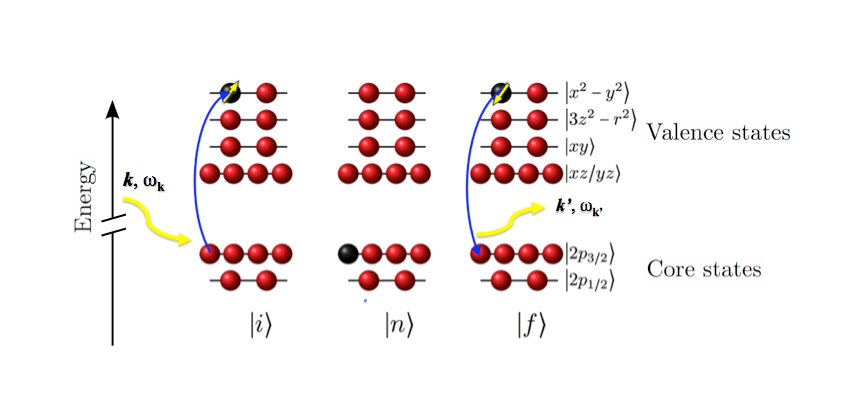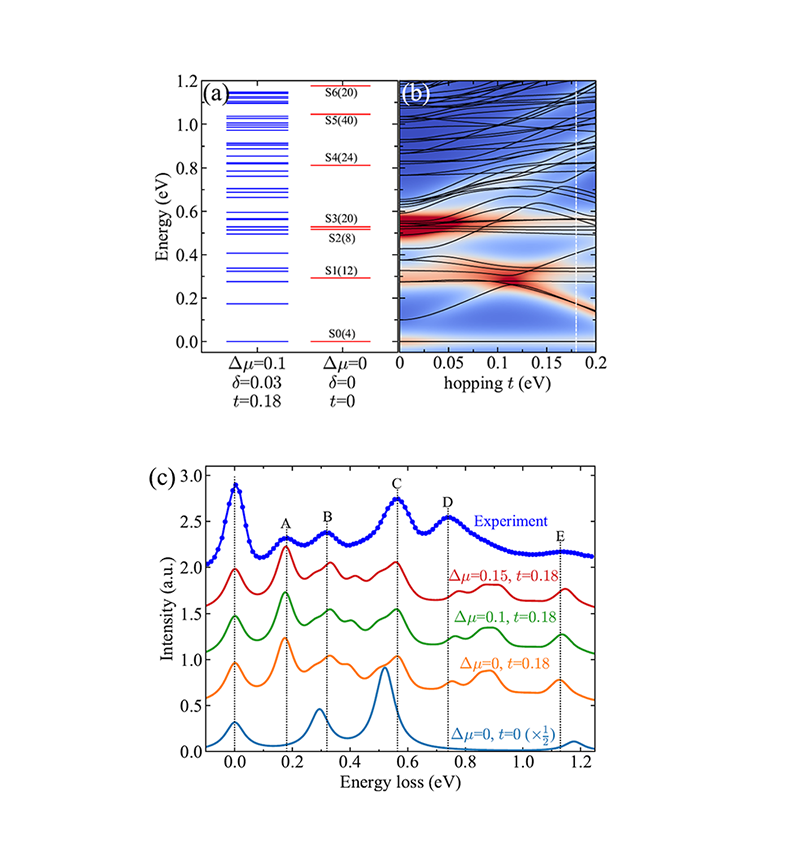Research
RIXS Spectroscopy
Resonant Inelastic X-ray Scattering (RIXS) is a photon-in photon-out spectroscopic method to measure the elementary excitations of materials. The energy of the incident photon is tuned at a specific resonant edge to excite a core electron to the valence bands. After a very short time, the core hole is refilled by a valence electron and a photon is emitted. See the illustration below. By measuring the change of the scattered photon's energy, momentum, and polarization, one can obtain detailed information about the underlying excitations in the material. Because RIXS can be used to study charge, magnetic, lattice, and orbital excitations, it has great potential for probing low energy physics in correlated electron materials. [Rev. Mod. Phys. 83, 705-767 (2011)]. It is element resolved, orbital resolved, bulk sensitive, and compatible with small samples. With the advent of x-ray free electron lasers, RIXS can even be applied to ultra-fast transient states. [Nat. Mat. 15, 601-605 (2016)]

Example of the RIXS process from J. Magn. Magn. Matt. 376, 3–13 (2015). The initial |i>, intermediate |n>, and final |f > states appear from left to right. Red spheres represent states filled by electrons and black spheres denote holes with up or down spin. Wavy yellow lines illustrate incoming and outgoing photons. The blue arrows depict transitions. In this process spin excitations are created with energy ℏωk-ℏωk’ and momentum ℏq = ℏk-ℏk’.

Examples of the simulated RIXS spectra on Ba5AlIr2O11 at the L3 edge of Ir (2pà 5d). These figures are from Phys. Rev. Lett. 122, 106401 (2019). The theoretical predictions were generated by EDRIXS.
Yilin Wang, a member of Comscope, developed the open source EDRIXS code to simulate the cross-section of RIXS on strongly correlated materials. It exactly diagonalizes Hamiltonians of a single-atom model, small cluster model or Anderson impurity model to obtain the ground states, and it uses the Lanczos method to calculate the excitation spectrum. The core-hole degrees of freedom and the core-hole potential are explicitly included at the atomic level because they have a strong effect on the spectrum.
EDRIXS is used by experimentalists including Mark Dean, a member of Comscope, to analyze experimental results obtained at the soft inelastic x-ray (SIX) beamline of the National Synchrotron Light Source II (NSLS-II). View the list of recent papers presenting EDRIXS results. Older EDRIXS papers include a study aimed to identify dimer orbitals in an iridate material Ba5AlIr2O11 [Phys. Rev. Lett. 122, 106401 (2019)] , and a study of the “hidden order” in URu2Si2 [Phys. Rev. B 96, 085146 (2017)].
Related Publications
- Resonant inelastic x-ray scattering studies of elementary excitations. Luuk J. P. Ament, Michel van Veenendaal, Thomas P. Devereaux, John P. Hill, and Jeroen van den Brink, Rev. Mod. Phys. 83, 705 (2011)
- Insights into the high temperature superconducting cuprates from resonant inelastic X-ray scattering. M.P.M.Dean, Magn. Magn. Matt. 376, 3–13 (2015)
- Ultrafast energy- and momentum-resolved dynamics of magnetic correlations in the photo-doped Mott insulator Sr2IrO4. M.P.M. Dean, Y. Cao, and J. P. Hill, Nat. Mat. 15, 601-605 (2016)
- On the possibility to detect multipolar order in URu2Si2 by the electric quadrupolar transition of resonant elastic x-ray scattering. L. Wang, G. Fabbris, D. Meyers, N. H. Sung, R. E. Baumbach, E. D. Bauer, P. J. Ryan, J.-W. Kim, X. Liu, M. P. M. Dean, G. Kotliar, and X. Dai, Phys. Rev. B 96, 085146 (2017)
- Direct Detection of Dimer Orbitals in Ba5AlIr2O1. Y. L. Wang, Ruitang Wang, Jungho Kim, M.H. Upton, D. Casa, T. Gog, G. Cao, G. Kotliar, M.P.M. Dean and X. Liu. Phys. Rev. Lett. 122, 106401 (2019)
- EDRIXS: An open source toolkit for simulating spectra of resonant inelastic x-ray scattering. Y.L. Wang, G. Fabbris, M.P.M. Dean and G. Kotliar. Computer Physics Communications 243, 151-165 (2019)








